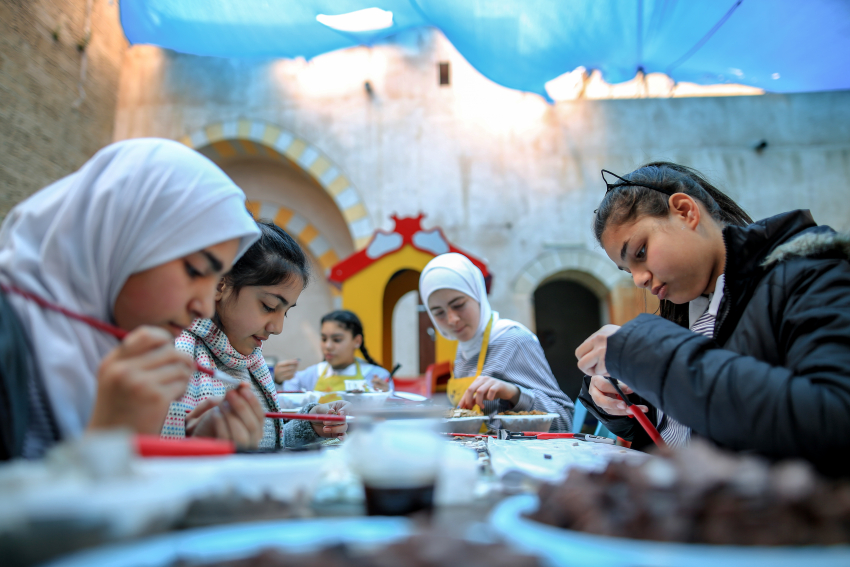

Gaza – (A.M. Qattan Foundation – 20 April 2019):
‘At the beginning I was excited, and after realizing the amount of work and effort it will take, I felt desperate. But after finishing my painting, I was happy and proud.’ This is how student Basma al-Tawil expressed her feelings about the mosaic making workshops she participated in, as part of the “Old Gaza” project which includes a group of 8th graders and their teacher, Ahlam Sheldan, from Banat ar-Rimal Secondary School. The project is part of the Professional Development Programme for teachers in Gaza implemented by the Educational Research and Development Programme (ERDP) of A.M. Qattan Foundation.
At an advanced stage of the project, the students worked with their teacher on exploring the archaeological site of the Byzantine Church in Jabalia, which, according to some sources, was built in 444AD. Students tried to learn more about society in that historical period; particularly focusing on cultural exchanges that potentially took place between Gazans, Byzantines and other travelers and pilgrims passing through.
The students conducted a survey of the church’s mosaic floor. They photographed it, and looked into its history and stories, and shared their questions with specialists on the archaeology and history of Gaza. The students also shared how they perceived the symbols engraved in the mosaics, their significance and how they interpreted their artistic forms.
During her visit, student Marah Hirzallah said ‘we returned to the location of the church again to take photos of the icons. In my opinion, the icons raise many questions that we can explore and imagine.’
The students shared their questions and arranged them in various categories that represent some aspects of ancient life. Then, in research groups, they tried to find answers. They also tried to compare the mosaic of the Jabalia church and the remains of its archaeological site, to the mosaic found in Saint Hilarion Monastery (Tell Umm Amer) in the south of Gaza, in order understand the past better.
‘We now know that we have an ancient, but oppressed culture that we need to preserve. We should revive it in all ways possible so that it does not disappear and die.’ Student Menna Khdeir commented.
Her colleague, Ka’inat Jirjawi said ‘When we analyse the photos and explore their details, we get to know people’s lives, and we can write our stories the way we imagine them in that period.’
The students and the teacher agreed to learn how to make mosaics, and to produce a collection of pieces that mimic some of the ancient symbols they chose and studied. They will then exhibit them to the community to share their stories about the pieces, and about the lives of people from that historical period.
Over two months, the students and their teacher were involved in a training workshop organised by the Educational Research and Development Programme, in collaboration with Iwan Centre for Architectural Heritage and architect Nashwa al-Ramlawi. During the workshops, students learned the steps of how to make mosaic starting with kneading raw materials, cutting, arranging them in artistic patterns and finally casting them in their final form.
The students agreed that they couldn’t appreciate the amount of effort it took the ancients to make mosaic and create the art pieces that cover archaeological sites, nor the different emotions they might have felt until they went through this experience themselves. ‘The workshops left a beautiful impact on us. They taught us patience and perseverance, and that if a person is determined to do something even if it is difficult, she will accomplish it.’ Farah al-Khouli, one of the students commented.
Another student, Asal Hanieh said ‘At first, I thought the workshops were going to be tiring and tedious, but after working and nearly completing the painting, I started seeing enthusiasm in the eyes of my group, and I wanted to work more, because we want to show others that we are young girls, who at our age, were able to do a wonderful and difficult work that many adults could not do.’
Ula Badawi, Manager of the ERDP Office in Gaza commented, ‘This project is one of the professional development projects through which we work together with teachers on producing a different understanding and experiencing of learning and of the role of the teacher and school. It explores the possibilities of enhancing the interaction of each individual with his/her world to find and create their own place in it, which can happen when the individual leads his/her own communal life. The project also explores what an interaction based on agreement and partnership between students and teachers with their surroundings can bring; not only in school but also in their social, cultural, familial life to discover more profound and comprehensive life-based learning opportunities.’
After finishing the mosaic making stage, the students and their teacher, in collaboration with the Educational Research and Development Programme, are currently working on developing the stories they produced, in order to organise community events related to their project.
